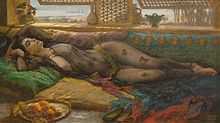Frederick Arthur Bridgman

Frederick Arthur Bridgman (November 10, 1847 – January 13, 1928) was an American artist known for his paintings of "Orientalist" subjects.

Born in Tuskegee, Alabama, he was the son of a physician. He began as a draughtsman in New York City, for the American Bank Note Company in 1864–65, and studied art in the same years at the Brooklyn Art Association and at the National Academy of Design. He went to Paris in 1866, and in 1867 he entered the studio of the noted academic painter Jean-Léon Gérôme (1824–1904), where he was deeply influenced by Gérôme's precise draftsmanship, smooth finishes, and concern for Middle-Eastern themes. Thereafter, Paris became his headquarters. In 1874, he was elected into the National Academy of Design as an Associate member, and became a full member in 1881.[1]

Bridgman made his first trip to North Africa between 1872 and 1874, dividing his time between Algeria and Egypt. There he executed approximately three hundred sketches, which became the source material for several later oil paintings that attracted immediate attention. Bridgman became known as "the American Gérôme", although Bridgman would later adopt a more naturalistic aesthetic, emphasizing bright colors and painterly brushwork. His large and important composition, The Funeral Procession of a Mummy on the Nile, in the Paris Salon (1877), bought by James Gordon Bennett, Jr., brought him the Cross of the Legion of Honor.
Additional visits to the region throughout the 1870s and 1880s allowed him to amass a collection of costumes, architectural pieces, and objets d'art, which often appear in his paintings. John Singer Sargent noted that Bridgman's overstuffed studio, along with the Eiffel Tower, were Paris's must-see attractions. Though Bridgman maintained a lifelong connection to France, his popularity in America never waned. Indeed, in 1890, the artist had a one-man show of over 400 pictures in New York's 5th Avenue galleries. When the show moved to Chicago's Art Institute, it contained only 300 works – testimony to the high number of sales Bridgman had made.

One of Bridgman's most recognized Orientalist images, A Street Scene in Algeria, is exceptional for its biographical and historical significance. Many of its details can be considered "signature" motifs of the artist, and its subject, a pointed record of travel. In keeping with Bridgman's tendency in the 1880s to focus on intimate domestic subjects, two seated male figures are given pride of place in the center of the composition, gesticulating while they chat.
Other paintings by him were An American Circus in Normandy, Procession of the Bull Apis (now in the Corcoran Gallery of Art, Washington, D.C.), and a Rumanian Lady (in the Temple collection, Philadelphia, Pennsylvania).
Recently, works by the painter have sold at auction in the price range of $250,000 USD to $350,000 USD.
References
Sources
 This article incorporates text from a publication now in the public domain: Chisholm, Hugh, ed. (1911). Encyclopædia Britannica (11th ed.). Cambridge University Press.
This article incorporates text from a publication now in the public domain: Chisholm, Hugh, ed. (1911). Encyclopædia Britannica (11th ed.). Cambridge University Press.- Additional information gathered and paraphrased from non-copyrighted auction information published by Sotheby's Auction House.
External links
| Wikimedia Commons has media related to Frederick Arthur Bridgman. |
- Museum of Fine Arts Boston
- Decorative works, salon pictures, eastern subjects and drawings by Frederic A. Bridgman, a full-text auction catalog from The Metropolitan Museum of Art Libraries
|